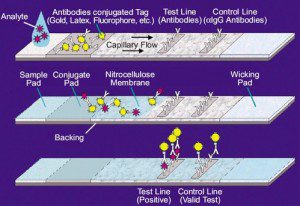

The format of the new assay, according to its developer, ArborVita, “is the familiar lateral-flow rapid antigen assay”. This type of diagnostic test is often designed to detect the presence of a protein in a clinical specimen, and is simple enough to be performed at home or in a physician’s office. The test sample is applied to a solid substrate, often a thin strip of nitrocellulose held in a plastic frame (illustrated). The nitrocellulose is impregnated with antibodies directed against the protein which is being assayed. These antibodies are labeled with colored latex or gold spheres to permit visual readout of the assay. The same antibody, minus the colored spheres, is bound along a line further down the nitrocellulose strip. When the clinical sample is applied to one end of the strip, it migrates by capillary action towards the opposite end. A protein that reacts with the labeled antibodies will also be bound by the immobilized antibodies as the complex moves down the strip. The result is a visible colored line on the filter indicating that protein is present in the sample. If no substance is bound to the antibody, it will move past the immobilized antibody and no color will develop.
A well-known example of a lateral-flow rapid antigen assay is the home pregnancy test, which is designed to detect human chorionic gonadotropin in urine.
The lateral-flow assay format has been used previously to detect influenza virus in clinical specimens, and depends on the presence of a viral protein called NP. Because the test involves the reaction of antibodies with proteins, it takes several hours to develop. Furthermore, the the kit must be refrigerated because antibodies lose activity at higher temperatures.
The new test for influenza H5N1 is novel because it does not depend upon an antibody-antigen reaction. Rather it uses the fact that another viral protein, called NS1, contains a binding sequence for a PDZ domain, a common structural motif found in many different proteins. PDZ domains bind with high specificity to short peptide sequences found in the carboxy-terminal regions of proteins. They are scaffolding proteins that play roles in signaling pathways involved in a variety of cell functions including membrane trafficking and cell polarity.
Examination of the protein sequences from many avian influenza virus isolates identified a PDZ ligand at the carboxy-terminus of NS1. The results of biochemical assays then showed that NS1 proteins from avian influenza viruses react with PDZ domains. Because the C-terminal region of the NS1 protein differs for each influenza subtype, a PDZ protein with high affinity for the NS1 protein of H5 viruses was selected for the assay. The NS1-specific PDZ domain is used in place of the antibody to capture the viral protein from clinical samples, such as a throat or nose swab. It is faster (40 minutes versus several hours) than antibody-based tests and does not require refrigeration.
The new assay is a simple, rapid, and stable test that can be used in many settings to monitor infection of humans with influenza H5N1 viruses. It is also a wonderful example of how unexpected research findings – in this case the discovery of a PDZ ligand in the viral NS1 protein – may lead to novel and effective clinical diagnostic reagents.
Obenauer, J. (2006). Large-Scale Sequence Analysis of Avian Influenza Isolates Science, 311 (5767), 1576-1580 DOI: 10.1126/science.1121586

Pingback: Novel rapid test for influenza H5N1 virus | www.homepregnancytest.ca
The comments above are a little misleading. Rapid influenza tests based on antibody detection of the NP protein (See Quidel, or Inverness web sites) have been available since 2000 Using lateral flow technology these tests usually give results in 20 minutes, not the several hours sugested above. They are CLIA waived and routinly run in doctors offices. In addition, the Arbor-Vita test does employ antibodies as part of the test to provide the detection signal. While this test is based on an intruiging technology, its application in the absense of significant incidence of H5 influenza infections is limited. The test is not useful at this time for detecting seasonal influenza.
H5N1 viruse…it reminds me of ths SARS occured in 2003.
My enquiry comes from Hong Kong
Would u mind e mailing me about how I can order this rapid test for H5N1 Ns 1 antigen from Hong Kong Supplier for my laboratory testing
Can this rapid test be made available in South Africa?
Thanks for such an informative post, I liked reading it!
Amber
Thanks for such an informative post, I liked reading it!
Amber